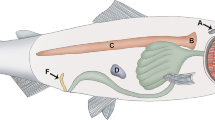Abstract
The functional properties of the haemocyanin ofVampyroteuthis infernalis (Cephalopoda: Vampyromorpha), measured at 5 °C, are reported and discussed in relation to hypoxia. The oxygen affinity of this haemocyanin (P50=0.47−0.55 kPa) is higher than any previously measured for a cephalopod. The high cooperativity (n50=2.20−2.23) and Bohr coefficient (−0.22) suggest a true transport function for this haemocyanin. This high-affinity haemocyanin, in conjunction with moderate gill diffusion capacity, provides a sufficient oxygen gradient from the environment to the blood to support the low routine oxygen consumption rate of V. infernalis
Similar content being viewed by others
Author information
Authors and Affiliations
Corresponding author
Rights and permissions
About this article
Cite this article
Seibel, B.A., Chausson, F., Lallier, F.H. et al. Vampire blood: respiratory physiology of the vampire squid (Cephalopoda: Vampyromorpha) in relation to the oxygen minimum layer. EBO 4, 1–10 (1999). https://doi.org/10.1007/s00898-999-0001-2
Received:
Accepted:
Issue Date:
DOI: https://doi.org/10.1007/s00898-999-0001-2




